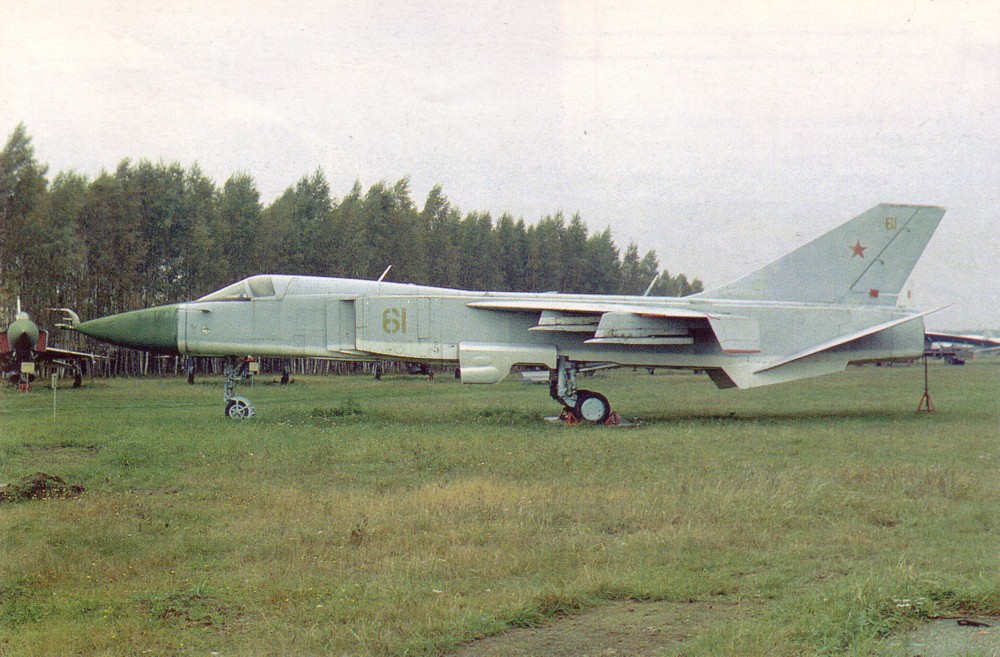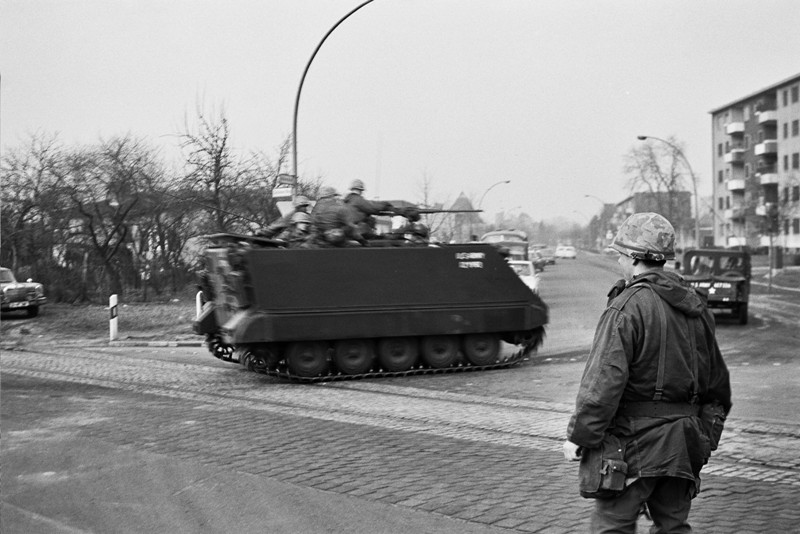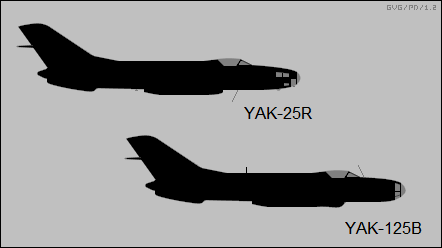|
Yak-28 Brewer
The Yakovlev Yak-28 () is a swept wing, turbojet-powered combat aircraft used by the Soviet Union. Produced initially as a tactical medium bomber, it was also manufactured in reconnaissance, electronic warfare, interceptor, and trainer versions, known by the NATO reporting names Brewer, Brewer-E, Firebar, and Maestro respectively. Based on the Yak-129 prototype first flown on 5 March 1958, it began to enter service in 1964. Design and development The Yak-28 was firstTaylor 1976, pp. 520–521. seen by the West at the Tushino air show in 1961. Western analysts initially believed it to be a fighter rather than an attack aircraft—and a continuation of the Yak-25M—and it was designated "Flashlight". After its actual role was realized, the Yak-28 bomber series was redesignated "Brewer". The Yak-28 had a large mid-mounted wing, swept at 45 degrees. The tailplane set halfway up the vertical fin (with cutouts to allow rudder movement). Slats were fitted on the leading edges an ... [...More Info...] [...Related Items...] OR: [Wikipedia] [Google] [Baidu] |
Medium Bomber
A medium bomber is a military bomber Fixed-wing aircraft, aircraft designed to operate with medium-sized Aerial bomb, bombloads over medium Range (aeronautics), range distances; the name serves to distinguish this type from larger heavy bombers and smaller light bombers. Mediums generally carried about two tons of bombs, compared to light bombers that carried one ton, and heavies that carried four or more. The term was used prior to and during World War II, based on available parameters of Aircraft engine, engine and Aerospace engineering, aeronautical technology for bomber aircraft designs at that time. After the war, medium bombers were replaced in world air forces by more advanced and capable aircraft. History In the early 1930s many air forces were looking to modernize their existing bomber aircraft fleets, which frequently consisted of older biplanes. The new designs were typically twin-engined monoplanes, often of all-metal construction, and optimized for high enough pe ... [...More Info...] [...Related Items...] OR: [Wikipedia] [Google] [Baidu] |
Tushino Air Show
In the life of Soviet Union, air shows were a highly regarded type of parade, almost always of military nature. They happened on various occasions and anniversaries, in many locations across the country. A notable air show was the Tushino Air Show held annually in August. Dates Soviet Air Fleet Day The most frequent date of air shows was the Soviet Air Fleet Day (). It was also known as the Soviet Air Forces Day (), or Soviet Aviation Day.Pre-history of MAKS - provides the complete information on Russian and Soviet air shows. It was established in 1933 and was most usually held on the third Sunday of August, weather permitting. The initial exhibition on 18 August 1933, was a result of in ... [...More Info...] [...Related Items...] OR: [Wikipedia] [Google] [Baidu] |
Sukhoi Su-24
The Sukhoi Su-24 (NATO reporting name: Fencer) is a supersonic, night fighter, all-weather tactical bomber developed in the Soviet Union. The aircraft has a variable-sweep wing, Twinjet, twin engines and a side-by-side seating arrangement for its crew of two. It was the first of the USSR's aircraft to carry an integrated digital Nav/attack system, navigation/attack system. The Su-24 started development in the early 1960s and first flew in 1967. It entered service in 1974 and production ceased in 1993. It remains in service with the Russian Aerospace Forces, Syrian Air Force, Ukrainian Air Force, Algerian Air Force and various other air forces to which it was exported. Development Background One of the conditions for accepting the Sukhoi Su-7, Sukhoi Su-7B into service in 1961 was the requirement for Sukhoi to develop an all-weather variant capable of precision air strikes. Preliminary investigations with ''S-28'' and ''S-32'' aircraft revealed that the basic Su-7 design was to ... [...More Info...] [...Related Items...] OR: [Wikipedia] [Google] [Baidu] |
Fall Of The Soviet Union
The Soviet Union was formally dissolved as a sovereign state and subject of international law on 26 December 1991 by Declaration No. 142-N of the Soviet of Nationalities, Soviet of the Republics of the Supreme Soviet of the Soviet Union. :s:ru:Декларация_Совета_Республик_ВС_СССР_от_26.12.1991_№_142-Н, Declaration No. 142-Н of the Soviet of Nationalities, Soviet of the Republics of the Supreme Soviet of the Soviet Union, formally establishing the dissolution of the Soviet Union as a state and subject of international law. It also brought an end to the Soviet Union's federal government and General Secretary of the Communist Party of the Soviet Union, General Secretary (also President of the Soviet Union, President) Mikhail Gorbachev's effort to Perestroika, reform the Soviet political and economic system in an attempt to stop a Era of Stagnation, period of political stalemate and economic backslide. The Soviet Union had experienced internal s ... [...More Info...] [...Related Items...] OR: [Wikipedia] [Google] [Baidu] |
Order Of The Red Banner
The Order of the Red Banner () was the first Soviet military decoration. The Order was established on 16 September 1918, during the Russian Civil War by decree of the All-Russian Central Executive Committee. It was the highest award of Soviet Russia, subsequently the Soviet Union, until the Order of Lenin was established in 1930. Recipients were recognised for extraordinary heroism, dedication, and courage demonstrated on the battlefield. The Order was awarded to individuals as well as to military units, cities, ships, political and social organizations, and state enterprises. In later years, it was also awarded on the twentieth and again on the thirtieth anniversary of military, police, or state security service without requiring participation in combat (the "Long Service Award" variant). Award history The Russian Order of the Red Banner was established during the Russian Civil War by decree of the All-Russian Central Executive Committee of September 16, 1918. The f ... [...More Info...] [...Related Items...] OR: [Wikipedia] [Google] [Baidu] |
RAF Gatow
Royal Air Force Gatow, or more commonly RAF Gatow, was a British Royal Air Force station (military airbase) in the district of Gatow in south-western Berlin, west of the Havel river, in the borough of Spandau. It was the home for the only known operational use of flying boats in central Europe, and was later used for photographic reconnaissance missions by de Havilland Canada DHC-1 Chipmunks over East Germany. Part of the former airfield is now called General Steinhoff-Kaserne, and is home to the Luftwaffenmuseum der Bundeswehr, the German Air Force Museum. Also on the site of the former Royal Air Force station, but not part of ''General Steinhoff-Kaserne'', is a school, the Hans-Carossa-Gymnasium, as well as houses for government employees of the Federal Republic of Germany. This part of the former airfield has since 2003 been part of the district of Berlin-Kladow. History Luftwaffe use, 1934–1945 The airfield was originally constructed in 1934 and 1935 by the Luftwaf ... [...More Info...] [...Related Items...] OR: [Wikipedia] [Google] [Baidu] |
Royal Navy
The Royal Navy (RN) is the naval warfare force of the United Kingdom. It is a component of His Majesty's Naval Service, and its officers hold their commissions from the King of the United Kingdom, King. Although warships were used by Kingdom of England, English and Kingdom of Scotland, Scottish kings from the early Middle Ages, medieval period, the first major maritime engagements were fought in the Hundred Years' War against Kingdom of France, France. The modern Royal Navy traces its origins to the English Navy of the early 16th century; the oldest of the British Armed Forces, UK's armed services, it is consequently known as the Senior Service. From the early 18th century until the World War II, Second World War, it was the world's most powerful navy. The Royal Navy played a key part in establishing and defending the British Empire, and four Imperial fortress colonies and a string of imperial bases and coaling stations secured the Royal Navy's ability to assert naval superior ... [...More Info...] [...Related Items...] OR: [Wikipedia] [Google] [Baidu] |
West Berlin
West Berlin ( or , ) was a political enclave which comprised the western part of Berlin from 1948 until 1990, during the Cold War. Although West Berlin lacked any sovereignty and was under military occupation until German reunification in 1990, the territory was claimed by the West Germany, Federal Republic of Germany (FRG or West Germany), despite being entirely surrounded by the East Germany, German Democratic Republic (GDR or East Germany). The legality of this claim was contested by the Soviet Union and other Eastern Bloc countries. However, West Berlin de facto aligned itself politically with the FRG from May 1949 and was thereafter treated as a ''de facto'' city-state of that country. After 1949, it was directly or indirectly represented in the institutions of the FRG, and most of its residents were citizens of the FRG. West Berlin was formally controlled by the Western Allies and entirely surrounded by East Berlin and East Germany. West Berlin had great symbolic signi ... [...More Info...] [...Related Items...] OR: [Wikipedia] [Google] [Baidu] |
Mach Number
The Mach number (M or Ma), often only Mach, (; ) is a dimensionless quantity in fluid dynamics representing the ratio of flow velocity past a boundary to the local speed of sound. It is named after the Austrian physicist and philosopher Ernst Mach. \mathrm = \frac, where: * is the local Mach number, * is the local flow velocity with respect to the boundaries (either internal, such as an object immersed in the flow, or external, like a channel), and * is the speed of sound in the medium, which in air varies with the square root of the thermodynamic temperature. By definition, at Mach1, the local flow velocity is equal to the speed of sound. At Mach0.65, is 65% of the speed of sound (subsonic), and, at Mach1.35, is 35% faster than the speed of sound (supersonic). The local speed of sound, and hence the Mach number, depends on the temperature of the surrounding gas. The Mach number is primarily used to determine the approximation with which a flow can be treated as an i ... [...More Info...] [...Related Items...] OR: [Wikipedia] [Google] [Baidu] |
Landing Gear
Landing gear is the undercarriage of an aircraft or spacecraft that is used for taxiing, takeoff or landing. For aircraft, it is generally needed for all three of these. It was also formerly called ''alighting gear'' by some manufacturers, such as the Glenn L. Martin Company. For aircraft, Stinton makes the terminology distinction ''undercarriage (British) = landing gear (US)''. For aircraft, the landing gear supports the craft when it is not flying, allowing it to take off, land, and taxi without damage. Wheeled landing gear is the most common, with skis or Seaplane, floats needed to operate from snow/ice/water and skids for vertical operation on land. Retractable undercarriages fold away during flight, which reduces drag (physics), drag, allowing for faster airspeeds. Landing gear must be strong enough to support the aircraft and its design affects the weight, balance and performance. It often comprises three wheels, or wheel-sets, giving a tripod effect. Some unusual land ... [...More Info...] [...Related Items...] OR: [Wikipedia] [Google] [Baidu] |
Tumansky R-11
The Tumansky R-11 (initially AM-11) is a Soviet Cold War-era turbojet engine. Design and development The Tumansky R-11 was developed by A.A. Mikulin, Sergei Tumansky, and B.S. Stechkin as a twin-spool axial-flow high-altitude non-afterburning turbojet for Yakovlev Yak-25RV reconnaissance aircraft. This engine was the first Soviet twin-spool turbojet. It was first run in early 1956Gunston 1989, p.167. and was later employed in some variants of the Yakovlev Yak-26 and Yakovlev Yak-27, as well as the Yak-28.Goebel, Greg"The Yakovlev Yak-25 & Yak-28."AirVectors. Retrieved: 17 July 2012. The R-11's basic design was very successful and it was later developed into the Tumansky R-13 and Tumansky R-25 along with the experimental Tumansky R-21. A total of 20,900 R-11 engines were built. Variants * R-11V-300 - first production version, high-altitude, non-afterburning * R-11F-300 (R-37F) - afterburning version, entered production in 1956, used on MiG-21F, P and U. * R-11AF-300 - i ... [...More Info...] [...Related Items...] OR: [Wikipedia] [Google] [Baidu] |
Yakovlev Yak-25
The Yakovlev Yak-25 (List of NATO reporting names for fighters, NATO designation Flashlight-A/Mandrake) is a swept wing, turbojet-powered interceptor aircraft, interceptor and reconnaissance aircraft built by Yakovlev and used by the Soviet Union. Design and development The Yak-25 originated from a need for long-range Interceptor aircraft to protect the USSR's northern and eastern territory. The specification for a two-seat, twin-engine jet fighter and a related reconnaissance aircraft was issued by Joseph Stalin on 6 August 1951. Yak-120 Yakovlev began developing a two-seat, twin-engine patrol interceptor, designated the Yak-120 by the design bureau, in 1951. It received official authorization by a directive of the Council of Ministers of the Soviet Union, Council of Ministers on 10 August of that year. In a break from previous Yakovlev designs, the Yak-120's thin, mid-set wings were swept back at a 45 degree angle with large two-section flaps. To provide more directional s ... [...More Info...] [...Related Items...] OR: [Wikipedia] [Google] [Baidu] |







